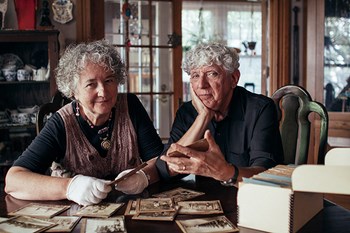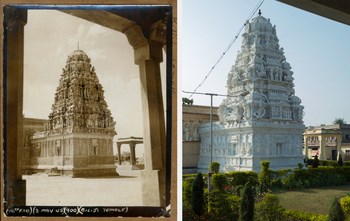For a quarter century, Jerri Zbiral
and Alan Teller have been trying to figure out the identity of
the photographer responsible for a treasure trove of images
from 1940s India.

Jerri Zbiral and Alan Teller with their 130 found photos
Jeffrey Marini
When Jerri Zbiral and Alan Teller first saw
the shoebox half-hidden beneath a couch, they had no idea that
it would, 25 years later, develop into an obsession that would
take over not only their lives, but the lives of dozens of
artists, scholars, students, and soldiers, and send them on an
epic quest halfway around the world. At the time, it looked
like just another estate-sale curiosity: an ordinary shoebox
filled with 130 brown envelopes, each containing a
four-by-five-inch negative, with a black-and-white print
stapled to the front. The photos appeared to have been taken
in India. The only clue to their provenance was the notations
someone had made on the bottom of each negative that read
"10th PTU" with a date, most either 27 April or 3 May, 1945.
The box's previous owner, Zbiral and Teller's friend Irving
Leiden, had recently passed away. He'd picked it up somewhere,
but his widow didn't remember any details.
Zbiral and Teller paid $20 and took the box home. Only then
did they take a close look at the pictures. Most of them were of temples and scenes of rural
village life: people doing laundry, catching fish in a net,
threshing rice, plowing fields with a team of oxen, playing
the drums and sitar, stuffing betel nuts with spices to turn
it into paan. There was an anthropological quality to the
collection, as though the photographer were consciously trying
to document the villagers and customs that were hundreds, if
not thousands, of years old. What struck Teller and Zbiral
most of all, though, was the quality of the photos.
"Everything is perfect," Teller says now. "You have big
things of sky and portraits and temples, and they're all done
beautifully. Every single one is spot-on. They were not
snapshots. This was a serious professional."
There were also a few shots of American soldiers, which,
along with the fact that the captions used American, not
British, spelling, made Zbiral and Teller suspect that the
photographer had been an American GI stationed in India at the
end of World War II. This suspicion was reinforced by the last
few photos in the box, which were labeled "Okinawa," implying
he'd been transferred to another army base.
They replaced the old shoebox and envelopes with
archival-quality storage materials. They stuck it in a closet
for safekeeping, intending to get back to it soon. "That's
what we do," Zbiral says. "We have so much shit." And then, as
they put it, "life took over": their photography and film
projects, their jobs to pay the mortgage on their house in
Evanston—she as an art dealer and appraiser, he as a designer
of museum exhibits—and the raising of their two children.
Sixteen years later, in 2005, Teller taught a class at Lake
Forest College on photography and anthropology. It seemed like
an ideal opportunity to revisit the box of photos from India.
The collection raised questions about how cultures perceive
one another (both the photographer through his camera and the
subjects looking back), and it gave the students material to
construct their own exhibit. One student in particular, Gwynn
Milbeck Stupar, became fascinated and began researching the
U.S. Army presence in India during World War II. She learned
that the Army Air Corps had maintained several bases in what
is now the state of West Bengal in order to fly reconnaissance
missions over the Burma hump into China to map out a possible
invasion of Japan. "10th PTU" stood for "10th Photographic
Technical Unit," the unit assigned to take aerial photographs
during those missions. It was likely, she thought, that the
photographer had been part of that unit.
Zbiral and Teller began to wonder if the backstory of the
photos went deeper than simply a curious American soldier who
liked to wander around with his camera. Based on the size of
the negatives, they suspected he had probably used a Speed
Graphic, an army-issued press camera. It was a heavy and
complex piece of equipment with f-stops and manual focus and
film holders that needed to be replaced after every shot.
Operating one required real skill. Were collections like this
one common?
"The Library of Congress told us there's an archive at
Maxwell Air Force Base," Zbiral remembers. "We sent them JPEGs
and asked, Is there anything like this in the archive? They
wrote back, 'This is amazing! We've never seen anything like
this.'"
The University of Chicago library has an archive of
southeast Asian photography, including a collection of photos
of Calcutta street life taken in the 1940s by an American
soldier who flew reconnaissance missions with the RAF, but
that collection didn't contain any pictures from the outlying
Bengali villages.
Teller and Zbiral showed their photos to Jim Nye, the
bibliographer of the U. of C.'s south Asia collection, and his
colleagues. "They went nuts," Teller says. "They were the
first to encourage us to pursue the project."
Ralph and Marta Nicholas, U. of C. scholars who'd done
anthropological fieldwork in rural West Bengal in the 1960s,
confirmed that the photos were indeed taken in West
Bengal—they recognized the landscape and the distinctive way
the women draped their saris—but they weren't sure exactly
where. Teller and Zbiral wondered if they could pinpoint the
villages by identifying the various temples.
Then the class ended, and life took over again. The photos
went back into the box.
Another five years passed. Zbiral and Teller's son, Max, a
musician, won a fellowship from the American Institute of
Indian Studies to study with a santoor master in Mumbai.
Zbiral and Teller decided to go visit. But they didn't want
just to be tourists. They wanted to explore with a purpose.
They pulled out the box again, made copies of all the photos,
and put them into a binder that they could carry with them.
Through the AIIS, they had access to photo archives and
scholars and government officials in Mumbai, New Delhi, and
Kolkata. They were able to identify one of the temples, the
Karanagarh Temple near the Piardoba airfield, the site of one
of the former U.S. Army air bases. They were slightly
disappointed that it was now bright orange—though it might
have been orange back in 1945 too; in black and white, it was
hard to tell—but that was less important than the fact that,
after so many years, they'd definitively found one place where
their photographer had been.
By then, their connection to him, whoever he was, had begun
to feel much deeper.
"In one town, we heard music," Teller recalls. "There was a
guy in front of a temple playing a harmonium. There were cows
in the background. I took a picture. The picture I took was
identical to the one our guy took. India is a weird place.
Part of it's in the 22nd century and part of it hasn't changed
for hundreds of years."

Balaji Temple in 1945 and 2014
Courtesy Jerri
Zbiral and Alan Teller
More>> |

